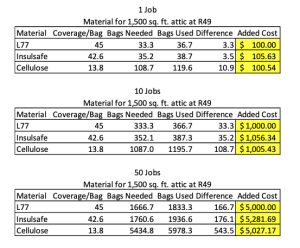Often, blowing hoses are the most overlooked piece in a fiberglass insulation blower system. When starting in insulation, you may see a blower hose as a means of taking material from the fiberglass blowing machine and delivering it to the attic or wall. Over the years, you’ll realize that the hose actually plays a big part in whether or not any money was made on the job. Most people don’t realize the impact hoses have on yield or getting the coverage stated on the bag.
HOW DO YOU KNOW WHEN TO CHANGE OUT YOUR HOSE?
When material leaves the fiberglass blowing machine, it’s only partially conditioned. The fiberglass insulation blower system actually finishes the process with the hose. Sharp-edged ribs in the hose break up or fluff up the fiberglass, which maximizes coverage. Over time, these ridges wear down and the inside of the hose will begin to smooth. Additionally, as the hose wears out, tiny holes open up throughout the hose causing air leakage. This leakage reduces blowing pressure, which means more clogging and less tumbling, resulting in less break-up and coverage. The end result: You use more material to do the same job and spend more money without making it.
DOES IT REALLY MAKE THAT MUCH OF A DIFFERENCE?
We made a video demonstrating the difference between an old hose and a new one on a fiberglass blowing machine. As you watch the video, you will see that even though our fiberglass blower hose wasn’t that bad, the results showed our yield decreased by 10% or more!
The charts below show the cost of using old hoses based on an average attic and a material price of $30/bag and cellulose at 9.25/bag.

HOW ELSE CAN I SAVE MONEY BY REPLACING AN OLD HOSE?
A big consideration we haven’t addressed yet is that material cost is only one factor of the downsides of using an old hose. Another factor of losing money with an old fiberglass blower hose is the labor used while handling the bags when loading the truck, loading the hopper, and the time it takes for an insulator to blow 10% more bags. Imagine what those costs would look like over a year.
The moral of the story is that you should replace the hose on your fiberglass blowing machine when you start to see duct tape covering holes in the hose. Better yet, start a schedule of using your blowing hoses for 6-9 months, then change the direction of the hose (move the end attached to the machine to the blowing end and attach the blowing end to the machine) and use for another 3-6 months. This will allow you to install the material at the correct coverage, ensuring the proper R-value for the customer and maximizing your material and profits. After that, replace it and watch your yields come back to where they should be.
MAKE MORE AND SAVE MORE WITH TIPS FROM THE INSULATION EXPERTS
For more tips and information on fiberglass or any of the products IDI carries, reach out to your local branch or contact us at the main office. Our goal is to help you grow profitably and we look forward to doing that every day.